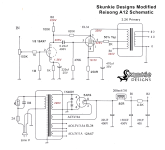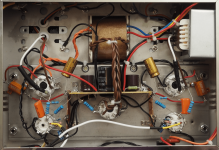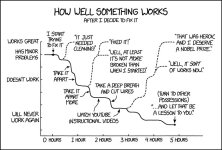So... here is the thing. I bought this Reisong A10 a few weeks ago and out of the box it was sounding terrible. At least matched with my Castle Conway speakers. So I started digging, reading and watching videos on how to mod it. I got to make some mods and tube rolling that enhanced the sound but... I'm still missing things. Rock and other "non-vocal/jazz/classical" tracks sound muddy. I need to add that I've no idea what I'm doing, I just follow the modding videos I find 😅. It was on one of them that I heard about bypassing the orange coupling cap (0.22uf) that came from factory with a copper foil cap (0.1uf).
Now, here is the "big question". I'm ready to spend some bucks on this bypass cap, but these questions came to me:
1. Sonically speaking, is it better to just replace the cap or bypassing (parallel) it with a lower capacitance would get more improvement?
2. If the case is the second, the capacitance of the bypassing cap affects the sound? Meaning, would it have more impact (improvement) if the bypass cap had 0.1uf than a 0.01uf? I ask this because I'm looking at some Duelunds that are quite expensive depending on capacitance.
That's it. All said (or asked). Please be kind to me, it's my first post.
Now, here is the "big question". I'm ready to spend some bucks on this bypass cap, but these questions came to me:
1. Sonically speaking, is it better to just replace the cap or bypassing (parallel) it with a lower capacitance would get more improvement?
2. If the case is the second, the capacitance of the bypassing cap affects the sound? Meaning, would it have more impact (improvement) if the bypass cap had 0.1uf than a 0.01uf? I ask this because I'm looking at some Duelunds that are quite expensive depending on capacitance.
That's it. All said (or asked). Please be kind to me, it's my first post.
Hola paisano 👍🏻
Your coupling cap is not the problem.
You can bypass it if you wish, but it will change nothing.
Foil material: copper - aluminum foil - deposited aluminum - whatever changes nothing, only capacitance matters.
If anything, dielectric might have some influence.
Your coupling cap is not the problem.
You can bypass it if you wish, but it will change nothing.
Foil material: copper - aluminum foil - deposited aluminum - whatever changes nothing, only capacitance matters.
If anything, dielectric might have some influence.
Hola amigo!
But many people say that it makes huge improvements. Not only on amplifiers but also on speaker crossovers, etc.. How's that so?
But many people say that it makes huge improvements. Not only on amplifiers but also on speaker crossovers, etc.. How's that so?
Many people vote for (Name your Poison politician), proving that people are interesting and clever individually, but easily manipulated in groups. A simple blind test, never mentioned in these "many people" discussions, quickly removes all doubt.
All good fortune,
Chris
All good fortune,
Chris
It looks very like my Chinese SE amp that also sounded awful and did not meet the claimed specs.
I did a thread on it here:
https://www.diyaudio.com/community/threads/chinese-el34-6sn7gt-se-unusual-topology.401911
I made a few mods such as constant current anode load for the 6SN7GT, removal of a resistor, etc.
It sounded good as a tweeter amp for my active speakers.
I tried a paper in oil interstage coupling cap but this made it too bright for my ears, so I went back to a PP (but not a Chinese one).
I did a thread on it here:
https://www.diyaudio.com/community/threads/chinese-el34-6sn7gt-se-unusual-topology.401911
I made a few mods such as constant current anode load for the 6SN7GT, removal of a resistor, etc.
It sounded good as a tweeter amp for my active speakers.
I tried a paper in oil interstage coupling cap but this made it too bright for my ears, so I went back to a PP (but not a Chinese one).
So about one third of the music will actually pass through the 'magic' caps, thenIt was on one of them that I heard about bypassing the orange coupling cap (0.22uf) that came from factory with a copper foil cap (0.1uf).

If you have either a stereo amplifier, or a pair of mono-blocks, do yourself a favor . . .
Build a switch-box that switches one input signal (Left channel music for example) to Ch1 or Ch2,
And switches one loudspeaker from Ch1 to Ch2.
Now, perform one, and only one, modification to Ch1.
Switch the music input to Ch1 then Ch2; and switch the loudspeaker to Ch1 then Ch2 respectively.
Caution: be sure your amplifiers will work with out a load.
If not, you need more switch contacts, and a load resistor to connect the load resistor to the un-loaded amplifier which is not currently connected to the loudspeaker.
The simplest, almost blind test, will reveal the facts about the difference in the sound of the modified amplifier, versus the sound of the un-modified amplifier.
Without that, you are AB testing, but relying on your brain's audio memory to make the comparison (not very good).
Have Fun!
Build a switch-box that switches one input signal (Left channel music for example) to Ch1 or Ch2,
And switches one loudspeaker from Ch1 to Ch2.
Now, perform one, and only one, modification to Ch1.
Switch the music input to Ch1 then Ch2; and switch the loudspeaker to Ch1 then Ch2 respectively.
Caution: be sure your amplifiers will work with out a load.
If not, you need more switch contacts, and a load resistor to connect the load resistor to the un-loaded amplifier which is not currently connected to the loudspeaker.
The simplest, almost blind test, will reveal the facts about the difference in the sound of the modified amplifier, versus the sound of the un-modified amplifier.
Without that, you are AB testing, but relying on your brain's audio memory to make the comparison (not very good).
Have Fun!
Better still, hide the switch box from view and have a family member or friend (many on here have neither 😉 ) operate the switch.
Wow, thanks a lot for the wisdom. Highly appreciated. So far this is the best idea ever, will try to do it:
This is also true, but I can't experiment with these caps, costing about 70usd each. Too much for me for later having to throw the loser away.
If someone could pls tell me the following I'd be able to finally place the order. I need to decide first if it's better to directly replace that cap or paralleling another, and then, if the parallel capacitance has more impact if I go with higher (yet very low) capacitance.
My real options after reading quite a lot of reviews about intestage coupling caps are:
I'd really like to go with the latter, but not sure such capacitance will really make any audible difference...
Pls help deciding 🙏🙏🙏. I can't afford buying all and then leave the losers laying around.
Luckilly I got to read the part of the load...Build a switch-box that switches one input signal (Left channel music for example) to Ch1 or Ch2,
And switches one loudspeaker from Ch1 to Ch2.
Now, perform one, and only one, modification to Ch1.
Switch the music input to Ch1 then Ch2; and switch the loudspeaker to Ch1 then Ch2 respectively.
Caution: be sure your amplifiers will work with out a load.
If not, you need more switch contacts, and a load resistor to connect the load resistor to the un-loaded amplifier which is not currently connected to the loudspeaker.
This is also true, but I can't experiment with these caps, costing about 70usd each. Too much for me for later having to throw the loser away.
Many people vote for (Name your Poison politician), proving that people are interesting and clever individually, but easily manipulated in groups. A
simple blind test, never mentioned in these "many people" discussions, quickly removes all doubt.
If someone could pls tell me the following I'd be able to finally place the order. I need to decide first if it's better to directly replace that cap or paralleling another, and then, if the parallel capacitance has more impact if I go with higher (yet very low) capacitance.
My real options after reading quite a lot of reviews about intestage coupling caps are:
- replacing the orange cap with a Duelund CAST PIO Pure copper 0.22uf (same uf as the original) - 65usd
- bypassing it with Duelund CAST PIO (77 usd) or JDM Tin-Copper (45 usd) 0.1uf
- bypassing with JDM Pure Silver 0.01uf (53 usd) or 0.022uf (72 usd)
I'd really like to go with the latter, but not sure such capacitance will really make any audible difference...
Pls help deciding 🙏🙏🙏. I can't afford buying all and then leave the losers laying around.
Wow, thanks a lot for the wisdom. Highly appreciated. So far this is the best idea ever, will try to do it:
Luckilly I got to read the part of the load...
This is also true, but I can't experiment with these caps, costing about 70usd each. Too much for me for later having to throw the loser away.
If someone could pls tell me the following I'd be able to finally place the order. I need to decide first if it's better to directly replace that cap or paralleling another, and then, if the parallel capacitance has more impact if I go with higher (yet very low) capacitance.
My real options after reading quite a lot of reviews about intestage coupling caps are:
- replacing the orange cap with a Duelund CAST PIO Pure copper 0.22uf (same uf as the original) - 65usd
- bypassing it with Duelund CAST PIO (77 usd) or JDM Tin-Copper (45 usd) 0.1uf
- bypassing with JDM Pure Silver 0.01uf (53 usd) or 0.022uf (72 usd)
I'd really like to go with the latter, but not sure such capacitance will really make any audible difference...
Pls help deciding 🙏🙏🙏. I can't afford buying all and then leave the losers laying around.U
You are about to launch yourslef down the rabbit hole of boutique components!
How can anyone tell you which to buy?
Do you ask someone which car to buy?
Don't waste your money.
Ok, then save yourself a few bucks (double or triple original cost once in Argentina thanks to "friendly" Customs):My real options after reading quite a lot of reviews about intestage coupling caps are:
- replacing the orange cap with a Duelund CAST PIO Pure copper 0.22uf (same uf as the original) - 65usd
- bypassing it with Duelund CAST PIO (77 usd) or JDM Tin-Copper (45 usd) 0.1uf
- bypassing with JDM Pure Silver 0.01uf (53 usd) or 0.022uf (72 usd)
All 3 you mention are highly advertised, very expensive mojo/faith/snake oil caps.
None will do anything to your sound but certainly affect your wallet.
People selling them have a 1000% markup (or higher) so they can afford to hire very poetic writers (notice NO measured specs are shown), but meaningless words such as blackness granularity soundstage , etc.
They also pay for Ad space in Audiophile magazines or pages, which guarantees flamboyant "reviews"
In the Real World: a coupling cap has a very simple job: to block DC and let Audio through.
Typically sized to have almost zero impedance compared to load, within the Audio band, (say they come from a 100k plate and go into a 1M grid) so no Audio voltage drop across, almost undetectable current through them, WHAT bad (or good) can they do to Audio?
They will CERTAINLY not improve a bad amp, that would be pure Magic or suggestion.
Nobody said the problem with your amp comes from a bad coupling capacitor, the most unlikely component.
I admit that in a speaker crossover the situation may be different, but there they are working, a very different job.
They are stopping frequencies in the middle of the Audio band, dropping important voltage, passing important current, their internal resistance is comparable to speaker impedance and affects it, the works.
But inside an Amplifier, as coupling caps?
Easiest job in the World.
I just wanna know the answer to the capacitance question, merely from a technical view. I knew it was going to be hard to get one though 😅.
If someone could pls tell me the following I'd be able to finally place the order. I need to decide first if it's better to directly replace that cap or paralleling another, and then, if the parallel capacitance has more impact if I go with higher (yet very low) capacitance.
@baudouin0 the schematics are these (after doing Skunkie's mods). Attaching a photo as well. The orange coupling caps are the ones that I'm asking about. Both cathode bypass caps already decided to go with AN Kaisei for driver stage and Elna Cerafine for output.
Stephe has already done a great job bettering the sound, but I want to upgrade some components as they are all factory/low quality ones I have in there. But any further consideration would be appreciated.
If someone could pls tell me the following I'd be able to finally place the order. I need to decide first if it's better to directly replace that cap or paralleling another, and then, if the parallel capacitance has more impact if I go with higher (yet very low) capacitance.
@baudouin0 the schematics are these (after doing Skunkie's mods). Attaching a photo as well. The orange coupling caps are the ones that I'm asking about. Both cathode bypass caps already decided to go with AN Kaisei for driver stage and Elna Cerafine for output.
Stephe has already done a great job bettering the sound, but I want to upgrade some components as they are all factory/low quality ones I have in there. But any further consideration would be appreciated.
Attachments
@JMFahey your posts are great, I really appreciate them, but I don't know why, perhaps because of all the marketing you mention there 😅, but I still somehow need to do this upgrade. I'll just feel better knowing that I did my best in trying to get the most out of it 🤣.
The other option is to reuse the beautiful casing and rebuild it from scratch with other schematics...
The other option is to reuse the beautiful casing and rebuild it from scratch with other schematics...
So then, to answer your questions:
1: Doesn't matter
2: No
Seriously, as long as the capacitors added are not ceramic then the above answers are valid. With ceramics you run a - slight - risk of microphonics.
Hal
1: Doesn't matter
2: No
Seriously, as long as the capacitors added are not ceramic then the above answers are valid. With ceramics you run a - slight - risk of microphonics.
Hal
Make sure the amp is operating properly before modifying anything.
Yes, yes, yes!Make sure the amp is operating properly before modifying anything.
And don't shotgun things... do a small change and then see if anything changed. Take notes and pictures as you go.
Attachments
- Home
- Amplifiers
- Tubes / Valves
- Interstage coupling cap replace or bypass?


